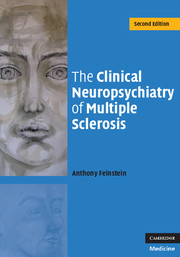Book contents
- Frontmatter
- Contents
- Acknowledgement
- Foreword
- 1 Multiple sclerosis: diagnosis and definitions
- 2 Depression: prevalence, symptoms, diagnosis and clinical correlates
- 3 Depression: etiology and treatment
- 4 Multiple sclerosis, bipolar affective disorder and euphoria
- 5 Multiple sclerosis and pseudobulbar affect
- 6 Multiple sclerosis and psychosis
- 7 Cognitive impairment in multiple sclerosis
- 8 The natural history of cognitive change in multiple sclerosis
- 9 Cognitive impairment in multiple sclerosis: detection, management and significance
- 10 Neuroimaging correlates of cognitive dysfunction
- 11 Multiple sclerosis, disease-modifying treatments and behavioral change
- 12 Multiple sclerosis: a subcortical, white matter dementia?
- Index
- Plate section
- References
12 - Multiple sclerosis: a subcortical, white matter dementia?
Published online by Cambridge University Press: 13 August 2009
- Frontmatter
- Contents
- Acknowledgement
- Foreword
- 1 Multiple sclerosis: diagnosis and definitions
- 2 Depression: prevalence, symptoms, diagnosis and clinical correlates
- 3 Depression: etiology and treatment
- 4 Multiple sclerosis, bipolar affective disorder and euphoria
- 5 Multiple sclerosis and pseudobulbar affect
- 6 Multiple sclerosis and psychosis
- 7 Cognitive impairment in multiple sclerosis
- 8 The natural history of cognitive change in multiple sclerosis
- 9 Cognitive impairment in multiple sclerosis: detection, management and significance
- 10 Neuroimaging correlates of cognitive dysfunction
- 11 Multiple sclerosis, disease-modifying treatments and behavioral change
- 12 Multiple sclerosis: a subcortical, white matter dementia?
- Index
- Plate section
- References
Summary
Medical taxonomy is subject to periodic revision, an inevitable consequence of new information derived from increasingly sophisticated clinical and laboratory investigations. The classification of dementia is a good illustration of this. For much of the past 100 years, the term dementia was considered synonymous with cortical pathology, of which Alzheimer's disease was the most frequent and well-described example. To be sure, Kinnear Wilson had, in 1912, described a distinctive pattern of neurobehavioral disturbance secondary to basal ganglia pathology, but his ideas were not developed in any systematic way for over 60 years. In the last quarter of the twentieth century, the concept of a different form of dementia primarily affecting subcortical structures and with a distinct clinical profile began to gain wider acceptance in psychiatry, neurology and neuropsychology. While some queried the validity of a distinct subcortical syndrome (Hakim and Mathieson, 1979; Whitehouse et al., 1982), their doubts gradually submerged under the weight of current opinion. More recently, however, new data derived from MRI of the brain and neuropathological investigation have opened up the debate anew.
The fourth edition of the Diagnostic and Statistical Manual of the American Psychiatric Association (DSM-IV) (American Psychiatric Association, 1994) has not created a specific category of “subcortical dementia” but has instead approached the issue of the classification of dementia in a more piecemeal fashion, by listing specific causes, many of which are essentially subcortical pathological processes, for example human immunodeficiency virus (HIV) infection, Parkinson's and Huntington's diseases and MS.
- Type
- Chapter
- Information
- The Clinical Neuropsychiatry of Multiple Sclerosis , pp. 232 - 256Publisher: Cambridge University PressPrint publication year: 2007



